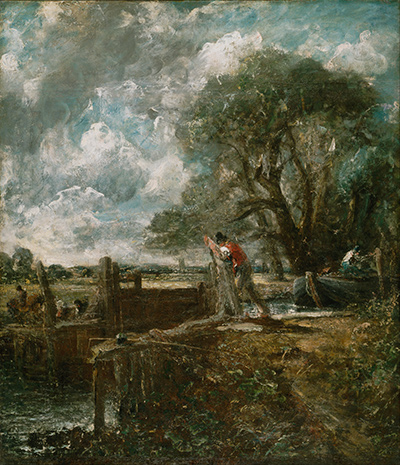Finished in 1824, The Lock is one of the six most famous paintings by the English artist popularly known as the Stour Series. How dearly he loved the piece of art can only perhaps be measured by his clinging to it until his death.
Not until then did it fall into the hands of a private collector and only emerged in the market after more than one-and-a-half centuries. While the artist chose it as a mark of his excellence and took it around various prestigious exhibitions, the painting has been in modern day displayed in New York, Los Angeles and Hong Kong.
Like most of Constable’s compositions, the Lock is all nature and beauty. He endeavoured to create a realistic look by making the water flow and the wind blow through the trees in the painting. Additionally, he proved his unrivalled talent by creating a depth by spicing up the green on the trees with reds and succeeded in breathing life to the trees, a rare feat in the days of classical landscapes.
In his early years, Constable would sketch clouds for hours. He eventually developed the skills that are evident in the formation of the clouds blended with sunlight. While The Lock is not the only work in which he displays these skills, it is an excellent example.
Painted on an oil canvas, the Lock is a depiction of rural Suffolk scene. In it, a man is struggling to open a canal gate in a location at Dedham Lock near Suffolk’s Flatford Mill with the aim of allowing a lighter surge of water to pour into River Stour. Across, there can be seen the typical water meadows typical in English country. Constable’s masterful skills emerge in the dramatic appearance of the cloudy sky and the tall great tree.
Born to a wealthy corn merchant in Suffolk, Constable’s attended the local village school for the better part of his childhood. Many of his youthful years were spent in Suffolk sketching the landscape which later became one of the most predominant features in his works of art. Even though his popularity in England never saw the light of day during his lifetime and he received better reception from French patrons in Paris, he remained loyal to his home country, only creating paintings of Suffolk landscapes.
He may be a household name in the art world but John Constable would be stunned by the homage he receives posthumously if he arose from the dead today.
Although he began his career early enough, he did not sell a single painting until his clocked 39. Even then, his homeland England did not appreciate his talent until his death when he left behind some of the most celebrated art works today.
Constable’s skill and talent in the art world is rivalled by few. Cherished by the artist and held in awe by art lovers, the Lock is perhaps the best of his work. It not only brings out the genius in the mind but the passion in the heart of the departed great artist.




